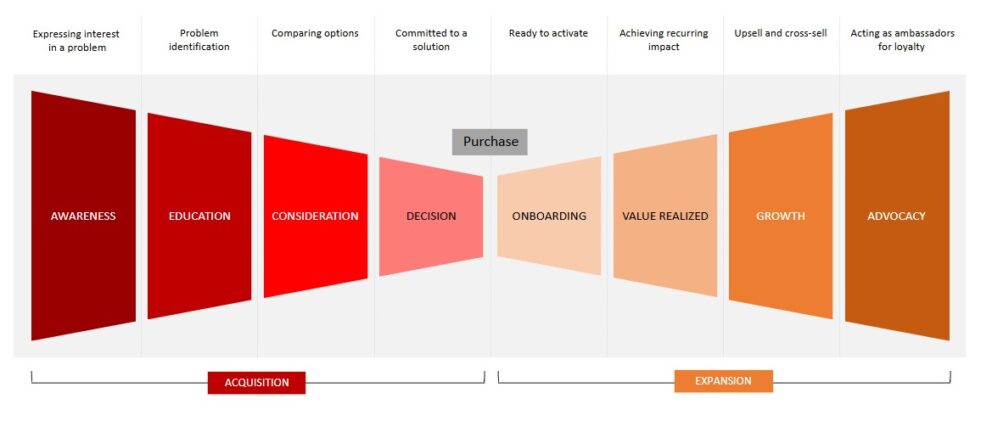People or Process? Redefining Roles with EOS
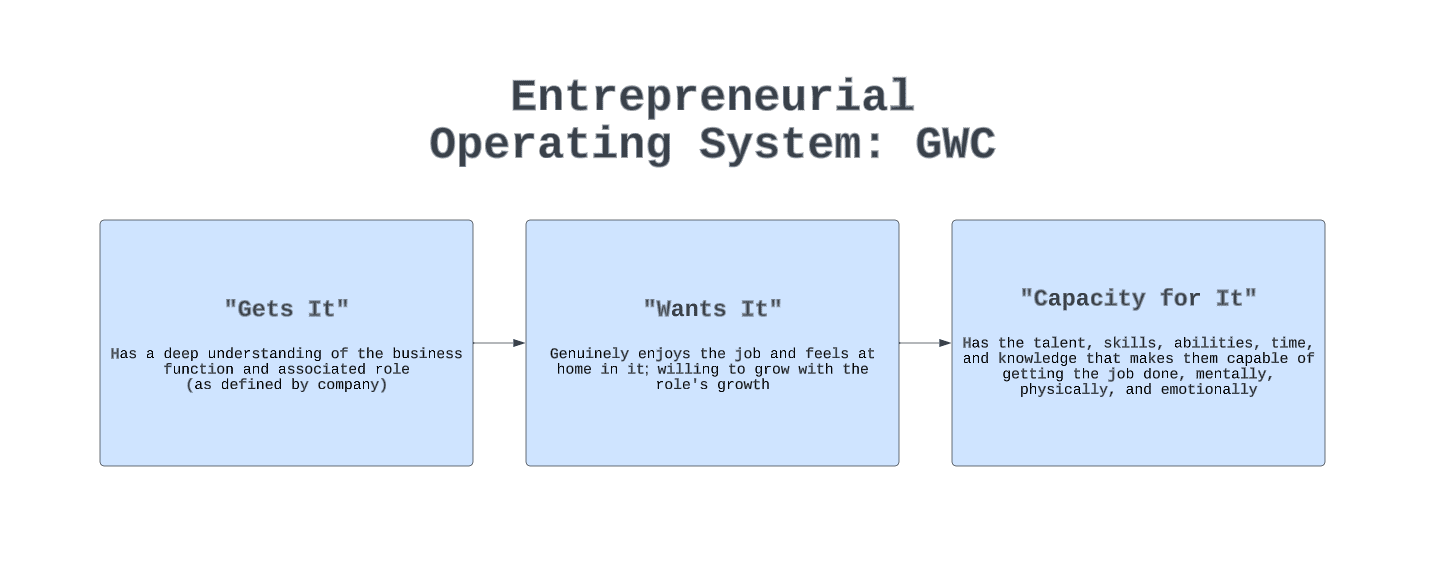
Summary
Trying to make improvements to your go-to-market process and still hitting snags? Unsure if the primary cause is a process problem or a people problem? In this blog, we use EOS's GWC framework, alongside a client example, to work through how we determine the root of the issue and apply the appropriate solutions.
By Sarah Threet, Marketing Consultant
Let’s say you’ve hired a consulting firm because you realize you keep hitting snags when trying to get your new marketing strategy out to market. Simply put, you’ve been in desperate need of a marketing orchestration overhaul. The consulting agency has helped you piece together a revamped holistic go-to-market process. Now it’s time to put it to the test…
In the testing process, you continue to hit wall after wall and nothing seems to be moving forward despite what seems like a fool-proof new process.
What’s the hold up? Some of the contributors are not meeting their delivery deadlines.
What’s preventing them from hitting deadlines? They’re unclear about what exactly they’re delivering.
At some point, whether it was when this person was hired or during this change management process, this contributor fell out of the loop with regards to the defined function of their role.
What now?
Defining Roles and Responsibilities with EOS
Entrepreneurial Operating System (EOS) is a framework we use at Heinz Marketing for business optimization. EOS stresses transparency and cohesion, and one of the key components of the framework is “getting the right people in the right seats”, because even having just one person in the wrong role can be quite disruptive to implementing new processes and delivering on time and quality.
To determine that we have the right people in the right seats, one of the tools used in EOS are the GWC basics: “Gets it”, “Wants it”, and has “Capacity” to do it. There must be a resounding yes to all three components of the tool.
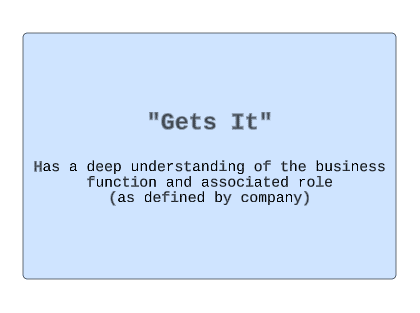
“Gets it”: The employee has a deep understanding of the business function and associated role (as defined by the company).
The responsibility of the company is to ensure a new hire “Gets” their job role and function during onboarding, but often new employees are hired at the last minute when everyone is too tied up with their own work to assist in proper onboarding. Sometimes an acquisition occurs and there isn’t an appointed person to assist with cultural and accountability alignment.
Set the proper expectations, explain their core values and organizational culture, train on their systems and processes, and describe how the employee’s role fits into the broader organization so they can comprehend what success looks like in their role. Otherwise, you have a lot of confused employees taking guesses and developing their own processes to support work they think they’re supposed to be doing.
Client example:
A large corporation became even bigger through the acquisition of a couple of other businesses. When the acquisition occurred, there was a lot of mismanagement with regards to aligning the organizational structure; suddenly there was a lot of people and uncertainty about where everyone would fit in the process (and uncertainty on what the process should look like moving forward).
A new Roles and Responsibilities deck was put together by the operations team but there was not a rollout in place by the time we were hired to consult this client. Ultimately, many employees were not communicated to about their changing responsibilities. This created communication and work silos among teams. Without the proper structure and onboarding in place, teams felt like they had to develop their own processes and use their own tools to finish work they perceived as priority (since there was also no prioritization process).
The solutions we helped develop with the client were:
- Defining and communicating new role responsibilities
- Developing a RACI to hold folks accountable through the process
- Defining the review process, and
- Developing a prioritization model
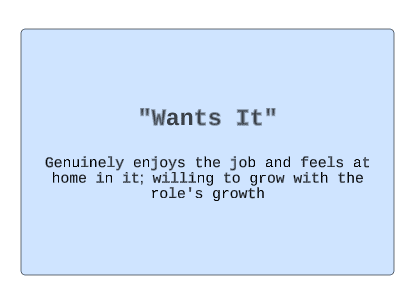
“Wants it”: This employee genuinely enjoys the job and feels at home in it. After understanding (“getting”) their role’s purpose, function, and metrics of success, this employee seems determined to do their best with this role.
It can sometimes be difficult to assess if someone really wants their role. They may want it but feel like they are not provided with all the resources and structure to do it right. When there is restructuring, it’s important to hear from your contributors what has been working and what has not been working, because you’ll need their buy in to the new way of doing things.
Change is also often difficult for most of us. It’s possible the employee did want their role, as it used to be defined, or only because they could do a process their own way. When the responsibilities of the role changes, and the process needs to be iterated upon, these changes may affect how the employee perceives their role, so it’s important to check in and see if this is still something this employee wants.
You may really like this employee, and you may want to provide them with a process that works for them, but in the end, you need to consider what process works best for the entire department, and not just for one team, or a handful of people resistant to change. Ultimately, their resistance may be the sign they are no longer a good cultural fit, even if they were once a pretty decent employee.
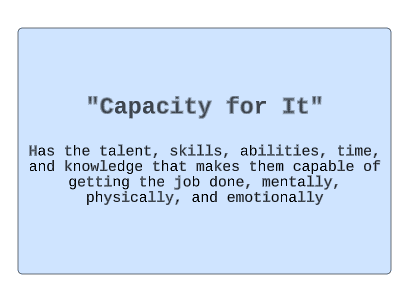
“Capacity”: The employee has the talent, skills, abilities, time, and knowledge that makes them capable of getting the job done, mentally, physically, and emotionally.
There is an exception to meeting this component: if the employee is not yet capable of doing this role, but you believe they are a great cultural fit who could be coached to be quickly capable, then you can invest those resources. Soft skills are the hardest to teach so if this person has those skills and is passionate about continuous improvement, they very well may be worth more to you than a more experienced candidate whose values don’t mesh.
Sometimes we aren’t always sure if someone is capable of the role they have been placed in until we see them do it. We can only really know if someone “gets” their new role in the testing of new processes.
Client example: The same client found through testing their new process some of the snags they were experiencing weren’t process-related, but people-related. We assisted them with the rollout of their new process (including newly defined roles and responsibilities) through training of their teams. Teams were provided with ample opportunity to give feedback and ask questions. Then we put together a campaign test so we could observe how everyone worked together going through the new planning to execution process.
Earlier during our discovery we found difficulty understanding one of the planning deliverables, particularly in understanding how it was compiled and presented to the campaign owner. We thought we came to a solution as to how this deliverable would be managed, and we thought we are all aligned with who would be responsible and accountable for the deliverable – in other words, we thought the contributors “got it” because they communicated to us they “got it”. Testing demonstrated otherwise.
In testing, we hit a roadblock trying to get this planning deliverable completed so we could move on to execution. There were hang ups about deliverable inputs, formatting, and how they wanted better tools for developing the deliverable. We discovered there had never been consistency on the formatting and inputs of this deliverable, which had caused a lot of strife for those on the execution side of things. It was not evident the planners responsible for this deliverable had never really “got” their role, even before the restructure, because they had never been capable of providing something complete.
The solution is twofold:
The obvious solution is these contributors may not be capable of doing their job and/or are unwilling to accommodate to changes; if either of these are evident in communicating expectations to them, then it may mean they are not a good fit.
The other solution relies heavily on leadership defining and consistently implementing cultural governance. Aligning on expectations also means aligning on the consequences should expectations not be met. When those consequences are never enforced by leadership, business will carry on as usual. Folks working between planners and doers (such as project management leaders) will never feel like they can enforce the process if leadership does not hold their teams accountable. In the case of this client example, leadership had us working primarily with marketing operations as leadership, but we needed to involve department leadership more in enforcing cultural governance.
How do you figure out if the snags you are experiencing are people-related or process-related?
Typically, it is a little of both causing you strife, but ultimately the answer comes down to testing.
To win the most buy-in for your new process, you’ll want to “interview” everyone involved in the planning to execution process and understand where they are currently feeling pains and what some of their suggestions may be – after all, these are the doers who are in the nitty-gritty details every day.
After you uncover areas of improvement and work with all stakeholders to develop something more efficient, you’ll want to communicate the new expectations and then test the process. Remember there will still always be areas in need of iteration and often you won’t know for sure if your process works better until you try it. The hold ups you experience may still very well be process-related, but if the same contributors seem to be involved in the hold ups, it’s always important to ask them why.
Recap:
- Clearly define your roles and responsibilities. Develop an accountability chart and/or RACI for clear communication. Ensure the employee is aligned and “gets it”.
- An employee will demonstrate they “want” a role, even when there are changes, when they are engaged with onboarding changes and willing to ask questions.
- Testing new processes is a great way to determine your employee not only “gets it” and “wants it”, but also has “capacity” to do it the way that the organization has agreed upon.
- Clearly define and communication your cultural governance and stick to enforcing expectations.

